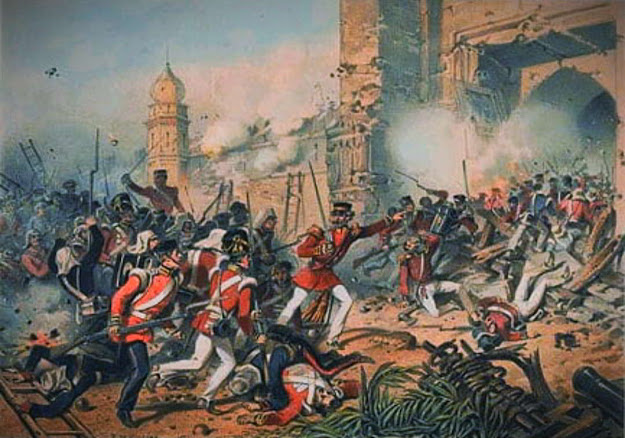Sepoy mutiny -Revolt of 1857
(Part -01)
Beginning Phase of the
Sepoy Mutiny 1857
A large number of
peoples (e.g.: peasants, Zamindars, kings, begin) believed that they have a
common enemy. Which was British East India Company. Zamindars and peasants both
were displeased with the High taxes and rigid method of revenue collection.
Many of them had failed to pay their loans. Therefore, moneylenders became more
powerful and peasants gradually lost their land which they had titled for
generations.
On the other hand,
Employees of the Company also had reasons for discontent. They were also
unhappy about their pay, allowances and conditions of service. New rules,
violated their religious sensibilities and beliefs. Sepoys believed that if
they crossed the sea, they world lose their caste and religion. Therefore,
in1824 they were told to go to Burma through the sea route they refused. In
1856 British passed a new law as “every new person who took up employment in
the Company’s army had to agree to serve overseas if required”.
Reason Behind the
Revolt:
- Mistreatment of the sepoys by the British rulers.
- Dalhousie announced in 1849 that Bahadur Shah ii would leave the Fort.
- Abolition of the titles and suspension of their pensions.
- Christian Religious activities by Christian Missionaries.
- Religious Disabilities Act of 1856.
- Other socio-religious causes.
- Political issues.
- Economic causes.
Administrative issues.
Mistreatment by British officials: In 1856, Lord canning’s government passed ‘General Service Enlistment Act’. Which decreased the all features to the Bengal army and they would have to serve anywhere.
The religious point of
view: The greased wrapping
paper of cartridge of the new Enfield rifle was made of beef and pig
fat(controversy). The cow was sacred to the Hindus, on the other hand, pig was
a taboo for the Muslims.
Economic Causes: Colonial policies of the British East
India Company destroyed the traditional economic structure of Indian Society.
The old System of Zamindari was forced to disintegrate. Moreover, British
policy totally discourages Indian handicrafts and traditional methods. Because
they just promoted British goods and equipment. Therefore, highly skilled
Indian traditional craftsmen were had to find out an alternative source of
income.
Administrative Causes: Rampant corruptions among the police,
petty officials and lower court was a major discontent. As we see now
Corruption in India is a legacy of the East India Company rule.
Social Reforms:
Religious Disabilities Act 1856, passed by the British Government, which
modified the Hindu customs. Because, British believed that Indian society had
to be reformed, such as abolition of Sati, widow marriage support, women’s
education (provided by outsiders) etc. Indian peoples began to believe that the
British were destroying their religion, culture, customs and traditional way of
life.
After 1830 Christian
missionaries and Company was actively promoted the English language
Education.
The reason behind the
failure of the ‘1857 Revolt’
- Lack of equipment and poor quality of arms.
- Absent of All India Participation.
- Lack of Unified ideology.
- All classes of the Society did not join.
According to Karl Marx’s view “It was the British intruder who broke up the Indian handloom and destroyed the spinning-wheel. England began with depriving the Indian cotton to the European market, it then introduced twist into Hindustan and in the end inundated the very mother country of cotton with cotton.”
According to John Lawrence “…had a single leader of ability arisen among them (the rebels). we must have been lost beyond redemption.”
Stanley Wolpert “It was
far more than a mutiny, yet much less than the first war of independence.”
Sepoy mutiny -Revolt of 1857 to be continued..
Fact Check: https://en.wikipedia.org/wiki/Indian_Rebellion_of_1857










No comments:
Post a Comment